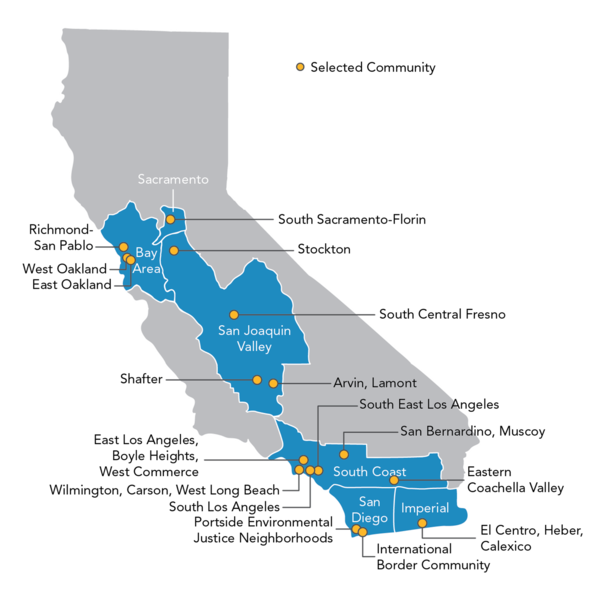|
SACRAMENTO -- The California Air Resources Board approved the Community Emissions Reduction Program (CERP) for the Arvin/Lamont community in Kern County. This is the fourth such program prepared by the San Joaquin Valley Air Pollution Control District in partnership with community residents, and the thirteenth approved by the Board as mandated by AB 617 (C. Garcia, Stats. 2017, ch. 136), which requires community-focused action to reduce air pollution and improve public health in communities that experience disproportionate burden from exposure to air pollutants.
The Arvin/Lamont Community includes the City of Arvin and the adjacent communities of Lamont, Hilltop, Fuller Acres, and Weedpatch. These Central Valley locations have long been overburdened by emissions from industrial sources, agricultural operations, oil production and extraction, dust, and heavy-duty truck traffic. Many neighborhoods are near farmland, making pesticide exposure a top community priority.
“The San Joaquin Valley is the breadbasket for California and the entire country, but it also has some of the worst air in the nation. We must ensure that the people in the communities that produce our food can breathe clean air where they live, work and play,” said Chanell Fletcher, CARB Deputy Executive Officer for Environmental Justice. “The enduring resilience of the Arvin/Lamont community shows in the way they came together to use the valuable tools provided by AB 617, in partnership with the Valley Air District, CARB, and other stakeholders to design a well-rounded CERP that will offer a breath of fresh clean air for local residents.”

Between March 2021 and August 2022, the Valley Air District convened an Arvin/Lamont Community Steering Committee that met monthly to develop the Arvin/Lamont CERP. The CERP includes regulatory, enforcement, and incentive-based strategies designed to reduce emissions and exposure to air pollutants prioritized by the residents of Arvin/Lamont.
The CERP focuses on reducing emissions and exposure to fine particulate matter (PM2.5), volatile organic compounds (VOCs), toxic air contaminants like those from pesticides, diesel particulate matter (DPM), and oxides of nitrogen (NOx) that come from sources such as heavy-duty trucks, passenger vehicles, and oil and gas operations. The Valley Air District estimates a lifetime reduction of 135.4 tons of PM2.5, 372.5 tons of NOx, and 148.3 tons of VOC from CERP measures.
Some of the air quality measures included in the CERP are incentive investments of $30 million toward projects like residential lawn and garden equipment replacement and agricultural equipment replacement, partnership measures to address pesticides, heavy-duty truck re-routing, and enhanced enforcement focused on stationary source inspections, fugitive dust, and heavy-duty truck idling. The CERP also calls on The Air District and CARB to work with the California Geologic Energy Management Division to assess oil well impacts on the community.
Outreach efforts include measures to help inform the community about their air quality and opportunities to improve it by reducing illegal burning and promoting the Healthy Air Living Program designed to help schools make informed decisions about outdoor activities in relation to air quality.
AB 617 Background
Since the implementation of AB 617, 17 community steering committees have been formed, 13 Community Emissions Reduction Programs have been approved by the Board, and many strategies have been developed to fight air pollution generated by agricultural activities, heavy duty trucks, railyards, and industry across California.
To address the requirements of AB 617, CARB created the Office of Community Air Protection (OCAP) to ensure the reduction of exposure and emissions of criteria air pollutants and toxic air contaminants in the most vulnerable areas of the state. OCAP staff participate in all AB 617 community steering committees, and provide guidance as requested by the Air District and CSC in the development of the community emissions reduction programs. OCAP and other CARB programs develop online tools to make data more accessible and useful in informing CERP decision-making.
Regional and Statewide Efforts
Generally, reduction strategies in community emissions reduction programs throughout the State target emissions for pollutants of concern and from sources of concern that are identified in collaboration with community residents. Successful implementation of the strategies requires strong partnership within the community steering committee and focused coordination between CARB, the local air district, and state and local land use and transportation agencies. CARB has identified emissions and exposure reduction approaches that all community emissions reduction programs should draw from to ensure a comprehensive and rigorous evaluation of potential reductions strategies, including regulations, enforcement, incentives, and mitigation strategies.
CARB continues its statewide efforts to achieve emissions reductions in all communities disproportionately impacted by poor air quality.
These efforts include:
|